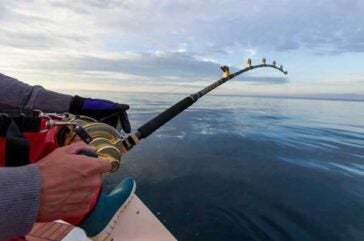By Susan B. Kennedy, Science Writer and Communications Specialist
April 2025 | STEEP Superfund Research Program
PFAS in our food chain: Researchers, regulators bring science and safety expertise to joint effort to enhance public guidance for eating wild caught fish, game
 Experts working to understand, address, and communicate the impacts of PFAS, a large group of toxic chemicals commonplace to home and work, have marked a new phase of the effort with an initiative to develop guidance so New Englanders can make informed choices about eating foods that could harbor PFAS.
Experts working to understand, address, and communicate the impacts of PFAS, a large group of toxic chemicals commonplace to home and work, have marked a new phase of the effort with an initiative to develop guidance so New Englanders can make informed choices about eating foods that could harbor PFAS.
Wild game, fish, and shellfish are foods of focus for the group of scientists and public health specialists who came together for a multi-day workshop, “Field & Stream: Confronting PFAS in New England’s Wild and Aquatic Foods,” in March 2025. They reviewed research, shared perspectives from the PFAS health and food safety arena in each of the states, and collaborated on practical steps for improving data collection, analysis, and communication with the public.
“As a science-based community, we’ve greatly improved the quality and quantity of data about the health risks associated with PFAS,” said Rainer Lohmann, director of STEEP (Sources, Transport, Exposure & Effects of PFAS Superfund Research Program), which convened the workshop for 30-plus science and health experts at the University of Rhode Island (URI) Bay Campus in Narragansett, RI from March 10 – 12. “Now we are targeting aspects of this risk, with one priority being how we can work together to improve public guidance on the consumption of wild-caught foods that could potentially be contaminated with these chemicals.”
Forever Chemicals in Our Ecosystems
For nearly a decade via STEEP, Lohmann, a URI chemical oceanographer, has worked with a network of colleagues to study PFAS – known formally as per- and polyfluoroalkyl substances – and engage the community in dialogue to understand and address the findings. The program takes a practical approach, sharing science both to illustrate health and environmental impacts, as well as inform people and communities on steps they can take to lessen contact with PFAS and lower risk. PFAS, invented nearly a century ago, bear no color or scent, and have been incorporated into the manufacture of many kinds of basic products found in homes, businesses, and community settings. For example, the chemicals often coat pizza boxes and microwave popcorn bags to prevent grease from soaking through, or they may protect furniture, carpet, coats, and boots from water and staining.
And science, such as that conducted via STEEP, has shown that PFAS can cause cancer and disrupt endocrine or hormone systems in people and animals, with no amount of the chemicals being deemed safe. As such, federal government and state efforts are underway to begin to address PFAS, with protection of drinking water resources from leaching chemicals in the ground being a primary focus. Similarly, recognition is growing of the impact that PFAS in the environment, on land and in water, are having on wild animals – fish, shellfish, and deer – caught or hunted as food for people.
That recognition, accompanied with increasing need on the part of the public health and food safety arena for strategies to accurately and clearly communicate PFAS risk information to consumers of wild fish, shellfish, and deer, served as an impetus for STEEP to start addressing the issue. The workshop, indicated Jon Petali, a Battelle senior toxicologist, represented a key opportunity for experts to collaborate on possible answers to myriad complexities posed by the consumption of PFAS tainted foods caught in the wild. “Science and public health are all about accuracy and clarity,” said Petali, “with the challenge here being to describe PFAS risk with accuracy and clarity in advisories, while also supporting the public in making informed choices about nutritional benefits of fish and other wild foods.”
Collaborating on Food Chain PFAS Challenges
Several challenges, said workshop participants in group discussions, make it difficult to establish clear-cut guidance about eating wild-caught foods that could contain PFAS. Some of the challenges have to do with data gaps and policy differences. While increased attention and resources on PFAS science is beginning to enable accurate and more widespread documentation of contamination in the ecosystem, significant gaps remain, with states often wending their owns paths forward.
From there, the challenges become even more complicated. One challenge concerns ecosystem complexity and species variance, with the extent to which an animal harbors PFAS being dependent in part on its particular attributes or habitat. For example, ocean-caught fish is generally considered safer, in terms of PFAS contamination, than lake or river dwelling fish, as larger marine environments can promote dilution of chemicals, while smaller water bodies may provide a concentrating effect – especially rivers in the region compromised for centuries by industrial pollution.
It’s this inherent nuance that makes the challenge of developing accurate and clear food safety guidance for the public so daunting. While locally sourced food is important for food security, it’s potentially a major source of exposure to a variety of PFAS that present risks at increasingly lower thresholds. Sharee Rusnak, an epidemiologist of the State of Connecticut Department of Public Health, said that “balancing the benefits of eating fish against PFAS risks” is critical, even while, regionally, funding and staff shortages complicate the work further.
And good news is happening, said others. For example, Mara Seeley, senior toxicologist at the Massachusetts Department of Public Health, shared information about a recent effort in the state to sample for PFAS in deer meat. “When we asked hunters to donate small samples of deer, we found they were very willing to provide these, and that was encouraging,” she said. Also, the public health arena today is increasingly interested in not only educating people, but in creating opportunities for productive dialogue that can ultimately improve the provision of guidance for complicated issues like PFAS risk in wild-caught foods. “We need to keep encouraging people to let us know how they want to get their public health information, and consider what information or which vehicles are most helpful for supporting them as they make choices,” said Kimberly Aviado, a toxicologist of the New Hampshire Department of Environmental Services, whose outreach efforts have included sharing public information in community-appropriate languages – Portuguese, Spanish, French, Nepali, and Chinese – in order to reach as many audiences as possible.
That kind of approach, making sure New England’s diverse constituencies are increasingly aware of both PFAS risks and nutritional benefits of wild-caught food, is incredibly important, said Jason Steiding, a member of the Mashpee Wamponaug Tribe in Massachusetts. He shared that his tribe regularly fishes and hunts for both economic and cultural reasons, so he wants to help raise awareness, while managing fears. “This is our culture, and while we have always hunted and fished, we want to be part of the discussion so we can make decisions about what or how much to consume,” he said. “This is an important issue for my community, and we need to be part of the answer.”
Moving Forward Food Chain Science and Practical Solutions
To support research, outreach, and communication efforts regarding PFAS risk in fish, shellfish, and game, the workshop group also took part in activities focused on furthering efforts to create several key products. While a peer-reviewed article is being prepared to document STEEP’s scientific findings thus far on PFAS as it concerns wild-caught animals, a toolbox of best practices for developing guidance on the issue for New England is in the works. The toolbox will package the science contained in key STEEP documents, including the article, and will reflect the participation of the workshop group in the creation of practical guidance that all New England states can use as they develop PFAS public health and food consumption advisories. Topics include risk assessment, management, and communication, as well as key issues identified by the states, such as sampling challenges.
And while the effort to understand and apprise the community of the complicated, nuanced issues concerning PFAS risk in wild-caught foods is only at the start, the workshop confirmed for Lohmann that momentum for solutions is being built every day. “If we can recognize how far we have already come in terms of documenting and communicating PFAS risks to humans and ecosystems, then we can move forward with more focused efforts, such as the impacts on the food chain,” said Lohmann. “At the most practical level, this is about improving our health, and that of our environments.”
This article was written by Susan B. Kennedy, a science writer and communications specialist with the University of Rhode Island who collaborates with the STEEP Superfund Research Program to translate complex environmental health topics into accessible stories for the public. This piece highlights outcomes from the March 2025 “Field & Stream” workshop focused on PFAS in New England’s wild and aquatic foods.

